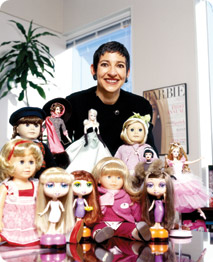What little girl in the last 40 years hasn't played with a Barbie doll, dreaming of the future when she is all grown up?
Created as a teenage fashion model in 1959, Barbie today is a career woman as well as a homemaker. She still has an extensive wardrobe, including wedding dresses and princess gowns, but also computer software and Barbie clothes for girls. Barbie is sold in more than 150 countries with one billion dolls purchased in the last four decades, according to toymaker Mattel, Inc. In fact, the average American girl between the ages of 3 and 11 now owns 10 Barbie dolls.
Overseeing this extensive empire is Adrienne Fontanella '81, president of the girls division of Mattel. In addition to Barbie, the division includes Cabbage Patch Kids, Polly Pocket!, Diva Starz, and American Girl. The popular American Girl brand features dolls that are personalized with the same color hair, eyes, and skin tones as an individual girl and a line of historical dolls representing seven 9-year-old girls who lived during different times in America's history.
How did an International Affairs graduate like Fontanella become responsible for an American icon like Barbie?
“I never in a million years envisioned myself in the toy business,” says Fontanella, even though she played with a Barbie doll as a girl and finds it interesting that Barbie was born the same year as most of the Class of 1981. “Barbie is the Martha Stewart role model for girls, an icon for 3- to 8-years-olds. American Girl spans the 8- to 12-age range. We have the ability to influence girls by building self-confidence, self-esteem, and self-empowerment. We're about empowering girls.”
Fontanella studied U.S.-Israeli relations with Ilan Peleg, Charles A. Dana Professor of Social Science and former head of International Affairs. “He was responsible for my early career,” says Fontanella, who worked at the Foreign Policy Research Institute at the University of Pennsylvania after graduation. “I've always been interested in global issues and international affairs since studying with him.”
FINDING A NEW YORK JOB
Deciding that she'd rather live in New York, Fontanella pounded the pavement hand-delivering résumés until she got a job on Wall Street as a mergers and acquisition analyst in the corporate finance department at E.F. Hutton, an investment banking firm. There she worked on Eli Lilly's divestiture of Elizabeth Arden. She joined Elizabeth Arden's strategic planning group, then became a marketing manager in their fragrance department.
“I fell in love with the cosmetic and fragrance industry,” Fontanella says. “I brought my strategic planning skills to marketing.” She moved to Parfum Stern as marketing director, shifting to Sanofi Beaute, Inc. when the French conglomerate acquired Parfum Stern. In 1995 she started her own fragrance business, creating Amphibia, a Kermit the Frog fragrance for adults, which parodied a Calvin Klein fragrance. The fragrance “did well and got a lot of publicity,” she says. The media exposure brought her to the attention of Mattel, which was looking for someone to develop a fragrance for Barbie. She joined Mattel in 1996 as vice president of new licensing ventures for Worldwide Barbie.
Fontanella grew a $200 million unit to over $800 million, significantly expanding the apparel, accessories, publishing, home furnishings, and stationery lines. In 1999, she was promoted to her current position as president of the girls division, which generates about $2 billion in sales annually. “I've enjoyed what I've done,” she says. “I've turned around the girls division and revitalized the [Barbie] brand. We have a new logo, new packaging, and a new face and body [for the doll].” The new shape features a more athletic, natural physique, with wider hips and a smaller bust.
BARBIE OF THE FUTURE
Managing a brand like Barbie from both a business and marketing perspective is a “fabulous challenge,” Fontanella says. Her focus is on “developing long-term brands, staying relevant [to girls], fashion-oriented, following trends and incorporating them into existing brands.” The company is attempting to capitalize on the preteen 7- to 12-year-old market with more trendy clothes, Barbie CD-roms and accessories, and expanding product lines such as activity sets. “The new Generation Girl [Barbie] has broadened the age-range appeal,” she says.
“The American Girl dolls teach American history,” she adds. “Each [doll] takes two years of research and a huge amount of work and detail. Each comes out with three books [about the character's life], then three more the next year.” A Depression-era doll, Kit, was introduced last year and is “a huge success.”
A new mother, Fontanella says “Harris is the joy of my life. I feel completely blessed.” Born last October, Harris is her first child. She is married to real estate developer Peter Culhane and has homes in Manhattan and California. With more than 30 nieces and nephews, she gets “lots of firsthand feedback on Barbie and American Girl.”
Fontanella's newest venture is Barbie in the Nutcracker, the first full-length, animated video with Barbie, and the debut of Quinceanera Barbie, celebrating the Hispanic tradition marking a girl's 15th birthday.

